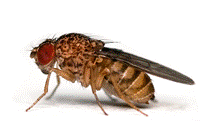Papers in the Biological Sciences

Lawrence G. Harshman Publications
Document Type
Article
Date of this Version
2004
Citation
Aging Cell 3 (2004), pp. 133–140; doi: 10.1111/j.1474-9728.2004.00098.x
Abstract
Survival under starvation conditions was investigated in relationship to survival when food was present because these traits could be linked by evolutionary history. Recombinant inbred lines de-rived from natural populations of Drosophila melanogaster were used to test genetic correlations and architecture of these survival traits. Sexes were genetically correlated within traits and there was significant correlation between survival traits. A number of quantitative trait loci (QTLs) were pre-sent for starvation survival and/or survival on food. In general, the QTL effects were consistent for sexes and environments. QTL effects were found on each major chromosome, but the major effects were largely localized on the second chromosome. Importantly, the “four-allele” progenitor of the recombinant inbred lines used in the present study allowed the sign and magnitude of effects to be assigned to linkage groups. One such linkage group on the second chromosome conferred starvation resistance and longevity, supporting the hypothesis of an association between starvation resistance and lifespan.


Comments
© 2004 Blackwell Publishing/Anatomical Society of Great Britain and Ireland. Used by permission.